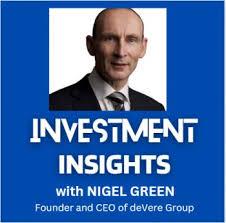The Fed's Pivot Is A Warning: Own Assets Or Lose Wealth
Central bankers rarely admit defeat. But Jerome Powell's latest remarks left little doubt: the Federal Reserve now sees the labour market faltering before inflation is fully tamed.
This shift in focus – from bringing down prices to protecting jobs – marks a profound change in the policy backdrop. For investors, it is a wake-up call.
For two years, the dominant story was inflation. Central banks tightened aggressively to restore credibility and slow surging prices.
Now the risks have flipped. Job creation is slowing, participation rates have plateaued, and business surveys point to softening demand. Even while inflation persists above target, the Fed is preparing to cut. That is no small matter.
History suggests this mix – weaker growth but stubborn inflation – is the most treacherous combination of all: stagflation. In the 1970s, oil shocks exposed the limits of monetary policy. Policymakers who eased prematurely locked in years of high prices, eroding household wealth and leaving markets volatile for a generation.
Today's context is different – technology, globalisation, and capital flows are more advanced – but the challenge is remarkably similar.
The Fed now finds itself forced to balance two contradictory risks. On the one hand, inflation is not dead. Core measures are still running above 2%, with services and housing showing resilience.
On the other hand, labour market indicators – job openings, quits, wage growth – are sliding. Powell's decision to prioritise jobs signals tolerance for higher inflation. That tolerance has huge implications for savers and investors.
Cash, often seen as a safe harbour, becomes toxic in this environment. Every month of above-target inflation quietly destroys purchasing power. And when central banks cut despite inflation, they effectively accelerate that erosion. Investors clinging to cash balances risk sleepwalking into wealth destruction.
This is why the message now is to own assets.
In a stagflationary world, traditional defensive strategies – government bonds, money-market funds – lose their protective qualities. The returns may look stable, but in real terms they are negative. Wealth preservation requires instruments with intrinsic value or pricing power.
Equities that can raise prices without losing demand remain critical. Firms with global reach, strong brands, and essential goods or services can defend margins when costs rise. Energy producers, resource exporters, and industrial firms tied to infrastructure often thrive in inflationary periods. Hard assets such as real estate, particularly in supply-constrained locations, offer a measure of protection. Infrastructure assets, which often carry inflation-linked revenues, can be resilient. And gold has for centuries served as a store of value when currencies weaken.
Newer hedges are entering the conversation too.
Bitcoin, with its finite supply, is increasingly viewed as a counterweight to policy-driven debasement of fiat money. It is volatile, but its appeal as“digital gold” is growing as deficits expand and central banks accept higher inflation as the price of supporting growth.
The policy context reinforces the urgency. Trade tensions are already lifting input costs. Tariffs and supply-chain frictions feed through directly to consumer prices. Meanwhile, soaring government deficits are pumping demand into an economy still running above its long-term capacity.
These dynamics make it almost impossible for central banks to restore 2% inflation without creating a recession. The Fed has effectively chosen not to push that far. The result will be higher prices for longer.
None of this means investors should despair. Opportunity is born in periods of dislocation. Stagflation widens the gap between winners and losers, creating both risks and extraordinary gains for those who position early. But what it does demand is decisiveness.
Waiting on the sidelines is not neutral; it's actively destructive. Inflation compounds against savers every month. Rate cuts against that backdrop lock in the erosion.
By the time mainstream commentary catches up to the word“stagflation,” the best opportunities will already have moved.
The winners will be those who accept the new reality now. Diversified portfolios anchored in real assets, exposure to sectors with pricing power, and strategic allocations to inflation hedges will protect and, in many cases, enhance wealth.
The lesson from Powell's shift is bigger than one speech. It is that we are entering a new policy regime. Inflation is no longer enemy number one.
Growth and employment carry the priority. That means investors can no longer expect central banks to defend the purchasing power of their cash. They must take that responsibility themselves.
The choice could not be starker: deploy capital into assets with enduring value, or watch savings corrode.
History teaches us that in stagflationary periods, indecision is the most costly mistake of all.
Nigel Green is deVere CEO and Founder
Also published on Medium .
Notice an issue? Arabian Post strives to deliver the most accurate and reliable information to its readers. If you believe you have identified an error or inconsistency in this article, please don't hesitate to contact our editorial team at editor[at]thearabianpost[dot]com . We are committed to promptly addressing any concerns and ensuring the highest level of journalistic integrity. Legal Disclaimer:
MENAFN provides the
information “as is” without warranty of any kind. We do not accept
any responsibility or liability for the accuracy, content, images,
videos, licenses, completeness, legality, or reliability of the information
contained in this article. If you have any complaints or copyright
issues related to this article, kindly contact the provider above.
Most popular stories
Market Research

- Daytrading Publishes New Study On The Dangers Of AI Tools Used By Traders
- Primexbt Launches Empowering Traders To Succeed Campaign, Leading A New Era Of Trading
- Wallpaper Market Size, Industry Overview, Latest Insights And Forecast 2025-2033
- Excellion Finance Scales Market-Neutral Defi Strategies With Fordefi's MPC Wallet
- ROVR Releases Open Dataset To Power The Future Of Spatial AI, Robotics, And Autonomous Systems
- Ethereum-Based Meme Project Pepeto ($PEPETO) Surges Past $6.5M In Presale






















Comments
No comment